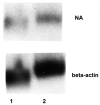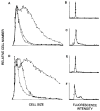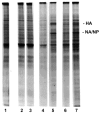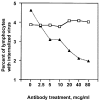Influenza Virus Infection of Human Lymphocytes Occurs in the Immune Cell Cluster of the Developing Antiviral Response
- PMID: 30103427
- PMCID: PMC6115886
- DOI: 10.3390/v10080420
Influenza Virus Infection of Human Lymphocytes Occurs in the Immune Cell Cluster of the Developing Antiviral Response
Abstract
Monocytes-macrophages and lymphocytes are recruited to the respiratory tract in response to influenza virus challenge and are exposed to the virus during the establishment of immune defenses. The susceptibility of human lymphocytes to infection was assessed. The presence of monocytes-macrophages was required to attain infection of both resting and proliferating lymphocytes. Lymphocyte infection occurred in the context of immune cell clusters and was blocked by the addition of anti-intercellular adhesion molecule-1 (ICAM-1) antibody to prevent cell clustering. Both peripheral blood-derived and bronchoalveolar lymphocytes were susceptible to infection. Both CD4⁺ and CD8⁺ T lymphocytes were susceptible to influenza virus infection, and the infected CD4⁺ and CD8⁺ lymphocytes served as infectious foci for other nonpermissive or even virus-permissive cells. These data show that monocytes-macrophages and both CD4⁺ and CD8⁺ lymphocytes can become infected during the course of an immune response to influenza virus challenge. The described leukocyte interactions during infection may play an important role in the development of effective anti-influenza responses.
Keywords: alveolar lymphocytes; human lymphocytes; human macrophages; human monocytes; immune cell clusters; influenza virus.
Conflict of interest statement
The authors declare no conflict of interest.
Figures










Similar articles
-
Diverse and Unexpected Roles of Human Monocytes/Macrophages in the Immune Response to Influenza Virus.Viruses. 2020 Mar 31;12(4):379. doi: 10.3390/v12040379. Viruses. 2020. PMID: 32244278 Free PMC article. Review.
-
Involvement of type I immune responses in swine-origin H1N1 influenza virus infection.Hum Immunol. 2011 Aug;72(8):632-5. doi: 10.1016/j.humimm.2011.04.006. Epub 2011 May 3. Hum Immunol. 2011. PMID: 21571020
-
High levels of virus-specific CD4+ T cells predict severe pandemic influenza A virus infection.Am J Respir Crit Care Med. 2012 Dec 15;186(12):1292-7. doi: 10.1164/rccm.201207-1245OC. Epub 2012 Oct 18. Am J Respir Crit Care Med. 2012. PMID: 23087026
-
Human T Lymphocytes Are Permissive for Dengue Virus Replication.J Virol. 2018 Apr 27;92(10):e02181-17. doi: 10.1128/JVI.02181-17. Print 2018 May 15. J Virol. 2018. PMID: 29514900 Free PMC article.
-
Cell-to-Cell Spread of HIV and Viral Pathogenesis.Adv Virus Res. 2016;95:43-85. doi: 10.1016/bs.aivir.2016.03.001. Epub 2016 Apr 4. Adv Virus Res. 2016. PMID: 27112280 Review.
Cited by
-
Effects of Receptor Specificity and Conformational Stability of Influenza A Virus Hemagglutinin on Infection and Activation of Different Cell Types in Human PBMCs.Front Immunol. 2022 Mar 14;13:827760. doi: 10.3389/fimmu.2022.827760. eCollection 2022. Front Immunol. 2022. PMID: 35359920 Free PMC article.
-
Pathogen class-specific transcriptional responses derived from PBMCs accurately discriminate between fungal, bacterial, and viral infections.PLoS One. 2024 Dec 12;19(12):e0311007. doi: 10.1371/journal.pone.0311007. eCollection 2024. PLoS One. 2024. PMID: 39666613 Free PMC article.
-
HLA-associated protection of lymphocytes during influenza virus infection.Virol J. 2020 Aug 24;17(1):128. doi: 10.1186/s12985-020-01406-x. Virol J. 2020. PMID: 32831108 Free PMC article.
-
The Enigma of Lymphocyte Apoptosis in the Response to Influenza Virus Infection.Viruses. 2023 Mar 16;15(3):759. doi: 10.3390/v15030759. Viruses. 2023. PMID: 36992468 Free PMC article.
-
Diverse and Unexpected Roles of Human Monocytes/Macrophages in the Immune Response to Influenza Virus.Viruses. 2020 Mar 31;12(4):379. doi: 10.3390/v12040379. Viruses. 2020. PMID: 32244278 Free PMC article. Review.
References
-
- Cerwenka A., Morgan T.M., Dutton R.W. Naive, Effector, and Memory CD8 T Cells in Protection Against Pulmonary Influenza Virus Infection: Homing Properties Rather Than Initial Frequencies Are Crucial. J. Immunol. 1999;163:5535–5543. - PubMed
Publication types
MeSH terms
Substances
LinkOut - more resources
Full Text Sources
Other Literature Sources
Research Materials
Miscellaneous

